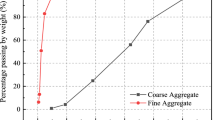Abstract
The application of textile reinforced mortar (TRM) as a means of increasing the shear resistance of reinforced concrete members is investigated in this study. TRM may be considered as an alternative to fiber reinforced polymers (FRP), providing solutions to many of the problems associated with application of the latter without compromising much the performance of strengthened members. Based on the experimental response of reinforced concrete members strengthened in shear it is concluded that textile-mortar jacketing provides substantial gain in shear resistance; this gain is higher as the number of layers increases and, depending on the number of layers, is sufficient to transform shear-type failure to flexural failure. TRM jackets were provided in this study either by conventional wrapping of fabrics or by helically applied strips. Both systems resulted in excellent results in terms of increasing the shear resistance. However, compared with their resin-impregnated counterparts, mortar-impregnated textiles may result in reduced effectiveness. Modelling of reinforced concrete members strengthened in shear with TRM jackets instead of FRP ones is presented by the authors as a rather straightforward procedure by the proper introduction of experimentally derived jacket effectiveness coefficients. From the limited results obtained in this study it is believed that TRM jacketing is an extremely promising solution for increasing the shear resistance of reinforced concrete members.
Similar content being viewed by others
References
fib bulletin 14, 2001, Externally Bonded FRP Reinforcement for RC Structures, Technical Report prepared by the Working Party EBR of Task Group 9.3, International Federation for Structural Concrete, July.
Teng JG, Chen JF, Smith ST, Lam L (2001) FRP Strengthened RC Structures, John Wiley & Sons.
ACI 549. 2R-04, 2004, Report on Thin Reinforced Cementitious Products, Reported by ACI Committee 549, American Concrete Institute, Farmington Hills, Michigan.
Kurtz S, Balaguru P (2001) Comparison of Inorganic and Organic Matrices for Strengthening of RC Beams with Carbon Sheets. Journal of Structural Engineering, ASCE, 127(1): 35–42.
Garon R, Balaguru PN, Toutanji H (2001) Performance of Inorganic Polymer-fiber Composites for Strengthening and Rehabilitation of Concrete Beams, FRPRCS-5 Fiber Reinforced Plastics for Reinforced Concrete Structures, CJ Burgoyne ed., Thomas Telford, London, V. 1, pp. 53–62.
Toutanji H, Deng Y, Jia M (2003) Fatigue Performance of RC Beams Strengthened with CF Sheets Bonded by Inorganic Matrix. FRPRCS-6 Fiber Reinforced Polymer Reinforcement for Concrete Structures, K. H. Tan, ed., World Scientific Publishing Company, V. 2, pp. 875–884.
Wiberg A (2003) Strengthening of Concrete Beams Using Cementitious Carbon Fibre Composites, Doctoral Thesis, Royal Institute of Technology, Stockholm.
Wu HC, Teng J (2003) Concrete Confined with Fiber Reinforced Cement Based Thin Sheet Composites', FRPRCS-6 Fiber Reinforced Polymer Reinforcement for Concrete Structures, K. H. Tan, ed., World Scientific Publishing Company, V. 1, pp. 591–600.
Gardiner T, Currie B (1983) ‘Flexural Behavior of Composite Cement Sheets Using Woven Polypropylene Mesh Fabric’, International Journal of Cement Composites and Lightweight Concrete, 5: 193–197.
Naaman AE, Shah SP, Throne JL (1984) Some developments of polypropylene fibers for concrete, Fiber-Reinforced Concrete–International Symposium, SP-81, G. C. Hoff, ed., American Concrete Institute, Farmington Hills, Michigan.
Bischoff Th, Wulfhorst B, Franzke G, Offermann P, Bartl A-M, Fuchs H, Hempel R, Curbach M, Pachow U, Weiser W (1998) TextileReinforced Concrete Façade Elements–An Investigation to Optimize Concrete Composite Technologies, 43rd International SAMPE Symposium, pp.1790–1802.
Curbach M, Jesse F (1999) High-Performance Textile-Reinforced Concrete, Structural Engineering International, IABSE, 4: 289–291.
Sato Y, Fujii S, Seto Y, Fujii T (1999) StructuralBehavior of Composite Reinforced Concrete Members Encased by Continuous Fiber-Mesh Reinforced Mortar Permanent Forms, FRPRCS-4 Fiber Reinforced Polymer Reinforcement for Reinforced Concrete Structures, SP-188, C. W. Dolan, S. H. Rizkalla and A. Nanni, eds., American Concrete Institute, Farmington Hills, Michigan, pp. 113–124.
Brameshuber W, Brockmann J, Roessler G (2001), TextileReinforced Concrete for Formwork Elements–Investigations of Structural Behaviour, FRPRCS-5 Fiber Reinforced Plastics for Reinforced Concrete Structures, C. J. Burgoyne, ed., Thomas Telford, London, V. 2, pp. 1019–1026.
Molter M, Littwin R, Hegger J (2001) Cracking andFailure Modes of Textile Reinforced Concrete, FRPRCS-5 Fiber Reinforced Plastics for Reinforced Concrete Structures, C. J. Burgoyne, ed., Thomas Telford, London, V. 2, pp. 1009–1018.
Mu B, Meyer C (2002) FlexuralBehavior of Fiber Mesh-Reinforced Concrete with Glass Aggregate, ACI Materials Journal, 99(5): 425–434.
Nakai H, Terada N, Honma A, Nishikawa K (2002) Improvement inPerformance of Concrete Structures by Using Sandy Fiber Mesh, 1st fib Congress, Osaka, Japan, Session 8, pp. 325–332.
Naaman AE (2003) Progress inFerrocement and Textile Hybrid Composites, 2nd Colloquium on Textile Reinforced Structures, Curbach M., ed., Dresden, pp. 325–346.
Peled A, Bentur A (2003) QuantitativeDescription of the Pull-Out Behavior of Crimped Yarns from Cement Matrix, Journal of Materials in Civil Engineering, ASCE, 15(6): 537–544.
Reinhardt HW, Krueger M, Grosse CU (2003) ConcretePrestressed with Textile Fabric, Journal of Advanced Concrete Technology, 1(3): 231–239.
Curbach M, Ortlepp R (2003) Besonderheiten des Verbundverhaltens von Verstaerkungsschichten aus textilbewehrtem, 2nd Colloquium on Textile Reinforced Structures, Curbach M., ed., Dresden, pp. 361–374 (in German).
Curbach M, Brueckner A (2003) Textile Strukturen zur Querkraftverstaerkung von Stahlbetonbauteilen, 2nd Colloquium on Textile Reinforced Structures, Curbach M., ed., Dresden, pp. 347–360 (in German).
Triantafillou TC, Papanicolaou CG, Zissimopoulos P, Laourdekis T (2006) ConcreteConfinement with Textile Reinforced Mortar (TRM)Jackets, ACI Structural Journal, 103(1): 28–37.
EN 1015-11, 1993, Methods of test for mortar for masonry–Part 11: Determination of flexural and compressive strength of hardened mortar, European Committee for Standardization, Brussels.
Khalifa A, Gold WJ, Nanni A, Aziz AMI (1998) Contribution ofExternally Bonded FRP to Shear Capacity of RCFlexural Members, Journal of Composites for Construction, ASCE, 2(4): 195–202.
Triantafillou TC, Antonopoulos CP (2000) Design ofConcrete Flexural Members Strengthened in Shear with FRP, Journal of Composites for Construction, ASCE, 4(4):198–205.
ACI 440.2R-02, 2002, Guide for the Design and Construction of Externally Bonded FRP Systems for Strengthening Concrete Structures, Reported by ACI Committee 440, American Concrete Institute, Farmington Hills, Michigan.
Author information
Authors and Affiliations
Rights and permissions
About this article
Cite this article
Triantafillou, T.C., Papanicolaou, C.G. Shear strengthening of reinforced concrete members with textile reinforced mortar (TRM) jackets. Mater Struct 39, 93–103 (2006). https://doi.org/10.1007/s11527-005-9034-3
Received:
Accepted:
Published:
Issue Date:
DOI: https://doi.org/10.1007/s11527-005-9034-3




